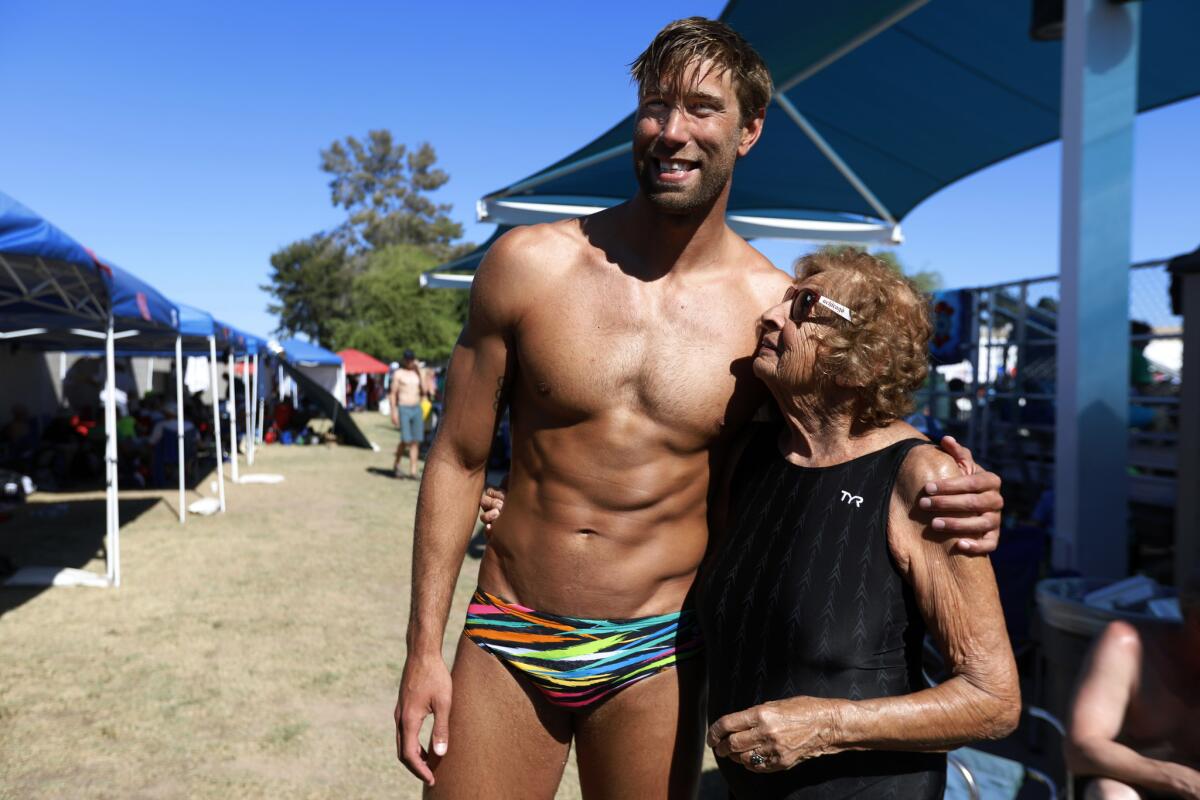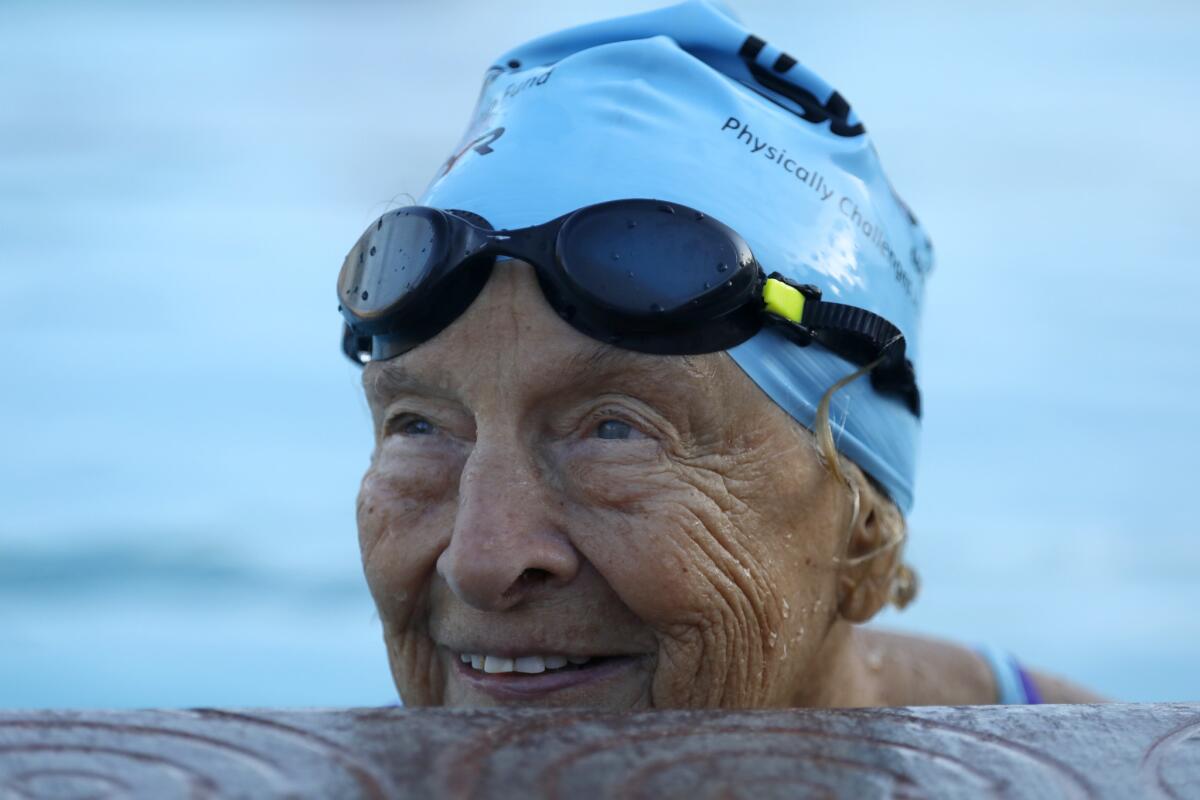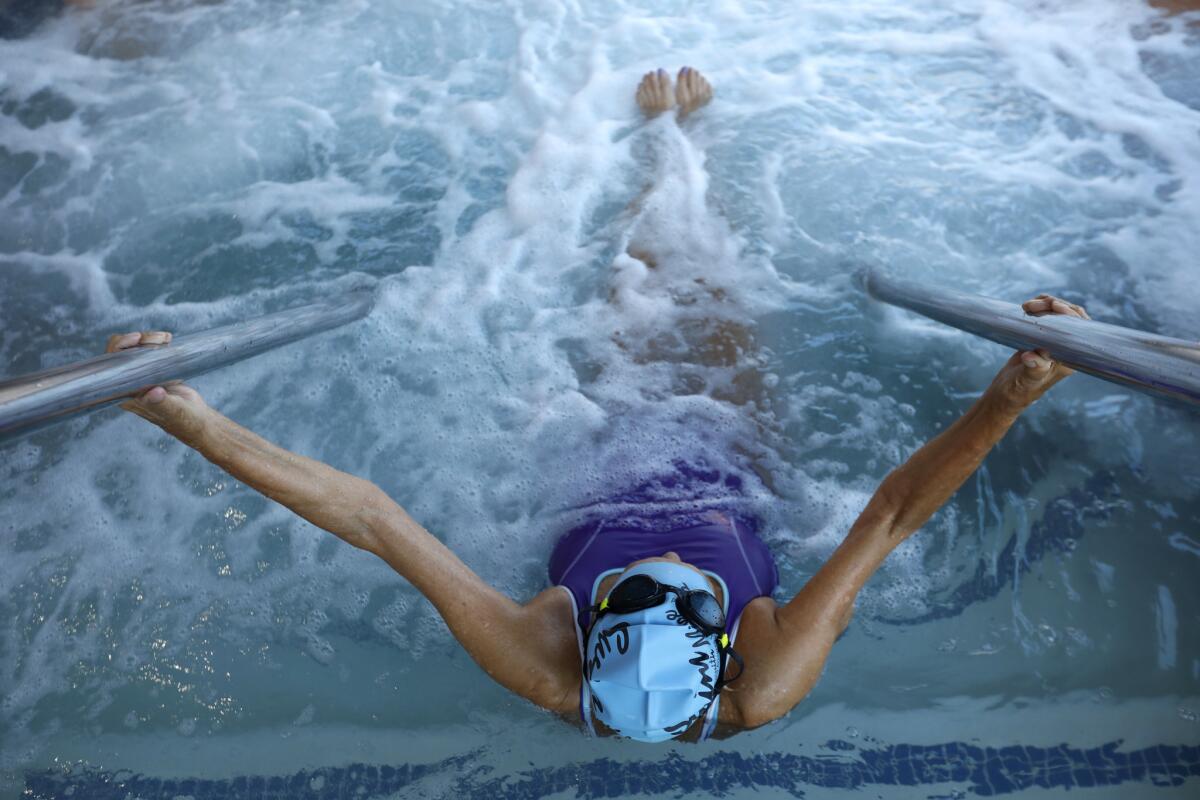Column One: Late to the pool, 97-year-old swimming champion has since lapped everyone

Maurine Kornfeld didn’t learn to put her face in the water until she reached retirement age. Now “the Mighty Mo” astounds swimmers a quarter of her age.
- Share via
She’s a champion swimmer who didn’t learn to put her face in the water until she reached retirement age. She’s a world record holder, but has only the vaguest notion of her fastest times. She’s a national champion in the backstroke who can tell you about the mechanics of the stroke, but would rather rhapsodize about the heavenly view one gets, swimming with her back to the world, sunny-side up.
Some people are born great, while others have greatness thrust upon them. So they say. Maurine Kornfeld sidled up to greatness in her own sweet time, letting it wash over her, while she paid attention to more important things.
Now the retired social worker, who didn’t swim her first serious lap until just before her 60th birthday, holds 16 age-group world records, 26 U.S. bests and dozens of national championship titles. Late last month, at the U.S. Masters Swimming Spring National Championship, the late bloomer from the Hollywood Hills bagged six more titles.
At 97, Mo Kornfeld is the oldest active member of the 64,000-member U.S. Masters Swimming. The menagerie of former high school and college swimmers, onetime Olympians and aquatic latecomers swim for fitness and — if so inclined — in regional, national and international competitions.
On the first day of the championship meet in suburban Phoenix, a sunburned woman looked across the riot of wet, spandex-clad bodies and spotted Kornfeld: “There’s the queen.” Addressing nearly 2,000 swimmers and spectators roasting in 102-degree heat, the P.A. announcer called Kornfeld’s aquatic exploits “titanic.” Head referee Teri White deemed Kornfeld, simply, “the star of the meet.”
Her teammates on Pasadena’s Rose Bowl Masters swim team will regale you with stories of “Mighty Mo” — her ability to navigate two freeways to make workouts, her obliteration of most world records in the 95-99 age group, and the lowdown on the time she humbled a Frenchwoman who dared claim that she would be the dominant nonagenarian at the 2017 World Championships.
“That’s all very nice,” Kornfeld said of the effusive praise. “But, I mean, it’s only swimming. It’s not going to change the course of world events.”

Indeed, as much as her swimming comrades talk about her records, they speak more passionately about the Kornfeld they know from the locker room, aqua aerobics class, and especially from the virtual salon she presides over while soaking in one of the Rose Bowl Aquatic Center’s giant hot tubs.
“She greets me so enthusiastically every time I see her, I feel like I am one of her favorite people,” said Nancy Niebrugge, a teammate at the Aquatic Center, located south of the historic stadium, which happens to be one year younger than Kornfeld. “Then, when I was around her a little longer, I realized she is that way with everyone. You feel special around Mo.”
Growing up in Great Falls, Mont., during the Great Depression, the daughter of Maurice and Mae Kornfeld hardly could have been certain she would find a life in the big world. “Nice girls didn’t do sports,” she recalled. Young women all appeared foreordained to become teachers, secretaries or nurses.
Kornfeld worked at her father’s menswear store, where she learned how to relate to strangers. And she spent long hours in the town library, where the children’s librarian encouraged a love of art and of adventurous reading.



By junior high, she listened to “The University of Chicago Roundtable,” a radio broadcast of scholars conversing on the great topics of the Western world. The university’s brilliant young chancellor, Robert Hutchins, particularly captured her imagination. (“My idea of education,” he once said, “is to unsettle the minds of the young and inflame their intellects.”)
Suitably inflamed, high school graduate Mo informed her parents that she wanted to attend the University of Chicago. “They were terrified at the thought,” Kornfeld recalled. “They were sure I would be met at the train station by Al Capone.”
Her time at the great university cemented a love of learning, of books, of theater and opera. “It was rubbing minds with some of the best and brightest,” she said. “I mean, what wouldn't be exciting?”
She got a bachelor’s and then master’s degree in social work and moved to Los Angeles, where a brother, Herb, had become a painter and commercial illustrator.
Kornfeld worked for Los Angeles Unified School District, and later for a program of the National Council of Jewish Women that provided childcare for working women, and still later for Cedars-Sinai Medical Center, in creating a foster grandparent program.

The ethic of social work, attending to those in need, echoed a Kornfeld family value. “You focused on others, not on oneself,” she said one day in her Craftsman bungalow, where Renoir light floods the cozy living room. “Remember, selfies hadn’t been invented yet. In any sense.”
In the 1970s, Kornfeld managed to dodge the decade’s fitness craze and the many permutations that followed. She liked to walk and hike in the hills above Los Angeles. But when she went to the Glendale YMCA one Saturday in 1982 for a swim, she was surprised to learn the “masters” had the pool reserved.
The coach told her that if she returned, she could try it out. At her first practice, coach Dom Neefe told her to swim the length of the pool and back. And she did, holding her face above water for all 50 yards, as she had learned at the old Morony Natatorium in Great Falls. “Put your face in the water!” Neefe implored. “Put your face in!” Kornfeld considered this “a bit vulgar.” But, eventually, she complied.
“You focused on others, not on oneself. Remember, selfies hadn’t been invented yet. In any sense.”
— Maurine Kornfeld
“And that Saturday led to another Saturday, and another Saturday and another,” she recalled. Not much later, Neefe told his 60-something novice to arrive early with a $7 entry fee and he would drive her to a meet. Her tank suit, with a skirt, hardly was built for speed, but she swam the 50-yard backstroke and 50-yard freestyle. And when the meet was over, someone handed her two blue ribbons — Top Novice. Remembers Kornfeld: “I was in awe.”
In the water, her arms swing a bit stiffly. She doesn’t kick as consistently as her coaches tell her to. And her reach is restricted, as you would expect for someone who has logged nearly a century on land and water.
But the swimmer — outfitted at practices in a periwinkle one-piece, with matching toenails — makes up for imperfect form with relentless function. Her arms churn furiously, completing more than double the number of strokes per pool-length as her younger peers. And she is known for closing strong — her final laps on race days often faster than her first ones.
“She loves the feel of the water,” said Jim Montrella, a onetime assistant Olympic coach, who along with his wife, Bev, has become Kornfeld’s mentor and dear friend. “And she is ahead of almost everyone when it comes to attitude.”
In Mesa, between heats, she huddled with companions old and new, like a swimmer from Kentucky she met a night earlier and now called her “dear friend.” Rose Bowl teammates circled and minded her, like remora fish tending to a mother shark. Cheryl Simmons untangled the straps on Kornfeld’s suit, Heidi Khalil passed along water and coach Chad Durieux planted his size-12 sneaker on the cement deck, to give his star a push-off point. (Kornfeld eschewed the starting blocks and dove from the pool deck.)

The only other woman to sign up for the 95-99 age bracket dropped out. That meant Kornfeld started her races alongside octogenarians. She beat a few of the younger swimmers and won her age group in all six of her individual events — at 50, 100 and 200 yards for both freestyle and backstroke — by default. She also competed in two relays.
Another swimmer drew stares and chatter at poolside — Matt Grevers, a six-time Olympic medalist and winner of the 2012 gold medal in the 100 backstroke. Grevers, 34, set an age-group record in the 50-yard backstroke, and U.S. Masters Swimming officials couldn’t resist getting the two together for a photo op.
“I admire you,” said the 6-foot-8 Grevers, beaming down and wrapping a meaty arm around the 5-foot-5 Kornfeld.
Behind the story: Learning about swimming and living a little from ‘Mighty Mo’ »
“No, I admire you,” she said.
While younger elite swimmers like Grevers struggle to knock hundredths of a second off world records, the performance boundaries in the upper age brackets are only beginning to be tested. Hitting the 95-99 group a couple of years ago, Kornfeld posted a time of 23:57.82 for the 1,000-yard freestyle. That was more than twice as fast as the previous national record of 50:44.12.
Last year, the International Masters Swimming Hall of Fame inducted Kornfeld into its ranks. She accepted the honor in Jacksonville, Fla., but mostly shrugs off such milestones.

“Aging up is an advantageous thing, even something to look forward to,” she said, adding with a laugh: “Up to a point!”
Coach Durieux sees no reason Kornfeld can’t rewrite the 100-104 age group records, suggesting she could “cut some of those records in half. But what really matters is that she is still swimming and having fun.”
Such late-life mastery is unusual, but not unique. In track and field, Kozo Haraguchi of Japan took up running at 65 and sprinting at 76. He then set the 95-99 age group world record for the 100 meters two times in two months, dropping the mark to 21.69 seconds.
Canadian Olga Kotelko had focused mostly on softball when, at 77, someone suggested she might have a knack for track and field. Sound advice. Kotelko at one point held 23 all-time age group marks in events like the javelin and hammer throw.
No one has offered a clear explanation for such late-life athletic prodigies. One theory is that life-long jocks have put too much wear and tear on joints and muscles by the time they reach their 90s, while late bloomers still have sound musculoskeletal systems, said Hirofumi Tanaka, director of the Cardiovascular Aging Research Laboratory at the University of Texas at Austin.
“These older athletes,” Tanaka said, “are getting faster and stronger.”

The old newbies have something else — delight in embracing their late-emerging power. They seem to have perfected the art of enjoying the moment.
“In the backstroke, I can look up and see the sky, the trees and the hills,” Kornfeld said. “Occasionally, you can even spot some Canadian geese flying by.”
If you listen closely, you’re in for another surprise — Kornfeld singing. Christmas carols are in regular rotation when she’s backstroking, though lately she's been warbling “Battle Hymn of the Republic.” Glory, glory, Hallelujah!
Kornfeld is ahead of the pack again, this time in front of 18 guests at the Los Angeles County Museum of Art, leading a tour of “Rauschenberg: The 1/4 Mile.” The exhibit is like the veteran docent — bright and multidimensional.
Kornfeld carries a fistful of notes, but she doesn’t consult them during the hour walkabout. She sprinkles Rauschenberg’s history with cultural touchstones — pointing out reaching fingertips that evoke Adam in the Sistine Chapel, a brilliant orange fabric that mimics a Buddhist monk’s saffron robes.
Kornfeld also leads tours for Los Angeles Metro at downtown’s Union Station. She paints verbal pictures of what it must have felt like in the 80-year-old station in years gone by. Here’s where young soldiers would stop for a shoe shine. There is where a bank of phone operators worked, and a girl just off the train from Iowa might stop to tell her aunt she had arrived in the Golden State.


“It was like she personally exuded the stature and historic value of that place,” said Ray Reisler, a retired nonprofit executive, who took the tour with his wife, Veronica. “She was not just giving facts. She was telling stories. It was astounding.”
Kornfeld treats the docent work like a job, carefully researching her subjects and then writing an outline that she constantly revises as she learns even more. Her favorite artist over 20 years of tours at LACMA? “Oh,” she answered without hesitation, “it’s whatever I’m working on right now.”
She’s lived by herself most of her life, but is constantly seeking new connections. In the hot tub, she relentlessly turns the conversation back to others — their work, their families, their travels. “People who are self-involved miss a lot in life,” she said. “Don't you think?”
The Mighty Mo has cut back on red meat in recent years. She’s given up wine. She sticks mostly to oatmeal for breakfast. But she is not one to offer pronouncements or formulas for longevity. She attributes her good life mostly to “dumb luck.”
And she’s too modest to suggest she will leave some legacy. But poking around her home, she makes a point of showing a candleholder she received in her girlhood, when the Camp Fire Girls promoted her to the highest rank, Torch Bearer.
The Torch Bearer believes the admonition she was given eight decades ago is worth remembering. “That light that has been given to me,” it said, “I desire to be given undimmed to others.”

Rainey is a special correspondent.
Go beyond the scoreboard
Get the latest on L.A.'s teams in the daily Sports Report newsletter.
You may occasionally receive promotional content from the Los Angeles Times.








